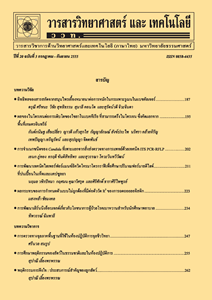การใช้เส้นใยและผงไทเทเนียมไดออกไซด์กำจัดสปอร์ของ Bacillus subtilis ในน้ำ
Main Article Content
Abstract
This study compared photocatalysis reactions from titanium dioxide powder (Degussa P25), concentrations of 0.001, 0.005, 0.01, 0.05 and 0.1 g/L, with nano-titanium dioxide fibers for inactivation of Bacillus subtilis spores. The fibers were synthesized from titanium (IV) isopropoxide and polyvinylpyrrolidone using electrospinning technic and calcined at the temperatures of 400-640 °C to obtain anatase to rutile ratio of 100 : 0, 70 : 30, 50 : 50 and 30 : 70. The fiber concentrations of 0.1, 0.25, 0.5, 1, 1.5 and 2 g/L were studied and concurrently compared with the best concentration of Degussa P25. Finally, the usage repetition of fibers for 5 times was investigated. The fiber-regeneration was conducted by heating at 100, 350, and 570 °C for 1 hour before each re-use. The experiment was conducted for 4 hours under sunlight irradiation. The results revealed that Degussa P25 at a concentration of 0.005 g/L yielded 100 % efficiency within 90-120 min, while a 1.5 g/L of the fiber with anatase to rutile ratio of 70 : 30 gave the highest efficiency, 80-99 %, within 210 min. For the usage repetition, regeneration temperature of 570 °C slightly yielded better efficiency than that of 350 °C. Both temperatures could regenerate fibers for 3 times of usage. However, the regeneration temperature of 100 °C showed the least efficiency rate.
Article Details
References
[2] Hamilton, J.W.J., Byrne, J.A., Dunlop, P.S.M. and Brown, N.M.D., 2008, Photo-oxidation of water using nanocrystalline tungsten oxide under visible light, Int. J. Photoenergy, 5 p., Article ID 185479.
[3] Li, L., Yalcin, B., Nguyen, B.N., Meador, M.A.B. and Cakmak, M., 2009, Flexible nanofiber-reinforced aerogel (xerogel) synthesis, manufacture, and characterization, ACS Appl. Mater. Interfaces 1: 2491-2501.
[4] Lee, S.A., Choo, K.H., Lee, C.H., Lee, H.I., Hyeon, T., Choi, W. and Kwon, H.H., 2001, Use of ultrafiltration membranes for the separation of TiO2 photocatalysts in drinking water treatment, Ind. Eng. Chem. Res. 40: 1712-1719.
[5] Chandrasekar, R., Zhang, L., Howe, J.Y., Hedin, N.E., Zhang, Y. and Fong, H., 2009, Fabrication and characterization of electrospuntitania nanofibers, J. Mater. Sci. 44: 1198-1205.
[6] Zhang, X.W., Xu, S.Y. and Han, G.R., 2009, Fabrication and photocatalytic activity of TiO2 nanofiber membrane, Mater. Lett. 63: 1761-1763.
[7] Yang, J., Li, D., Wang, X., Yang, X. and Lu, L., 2002, Rapid synthesis of nanocrystal line TiO2/SnO2 binary oxides and their photoinduced decomposition of methyl orange, J. Solid State Chem. 165: 193-198.
[8] Kakuma, Y., Nosaka, A.Y. and Nosaka, Y., 2015, Difference in TiO2 photocatalytic mechanism between rutile and anatase studied by the detection of active oxygen and surface species in water, Phys. Chem. Chem. Phys. 17: 18691-18698.
[9] Ngamsakpasert, C., 2015, Synthesis of Titanium Dioxide Fibers with Electrospinning for Carbendazim Residue Removal from Chinese Chives Using Photocatalysis, M.S. Thesis, Chulalongkorn University, Bangkok, 145 p. (in Thai)
[10] Ohno, T., Sarukawa, K., Tokieda, K. and Matsumura, M., 2001, Morphology of a TiO2 photocatalyst (Degussa, P-25) consisting of anatase and rutile crystalline phases, J. Catal. 203: 82-86.
[11] Nicholson, W.L., Munakata, N., Horneck, G., Melosh, H.J. and Setlow, P., 2000, Resistance of Bacillus endospores to extreme terrestrial and extraterrestrial environments, Microbiol. Mol. Biol. Rev. 64: 548-572.
[12] Nawarat, S., Supothina, S. and Chuaybam roong, P., 2010, Removal of Bacillus subtilis from wastewater using photocatalysis and ultraviolet-C, Thai Environ. Eng. J., 24(3): 33-42. (in Thai)
[13] Rincón, A.G. and Pulgarin, C., 2003, Photo catalytical inactivation of E. coli: effect of (continuous-intermittent) light intensity and of (suspended-fixed) TiO2 concentra tion, Appl. Catal. B: Environ. 44: 263-284.
[14] Pelizzetti, E., Pramauro, E., Minero, C. and Serpone, N., 1990, Sunlight photocatalytic degradation of organic pollutants in aquatic systems, Waste Manage. 10: 65-71.
[15] Liu, Z., Zhang, X., Nishimoto, S., Jin, M., Tryk, D.A., Murakami, T., Fujishima, A., 2007, Anatase TiO2 nanoparticles on rutile TiO2 nanorods: A heterogeneous nano structure via layer-by-layer assembly, Langmuir 23: 10916-10919.
[16] Doh, S.J., Kim, C., Lee, S.G., Lee, S.J. and Kim, H., 2008, Development of photo catalytic TiO2 nanofibers by electro spinning and its application to degrada tion of dye pollutants, J. Haz. Mat. 154: 118-127.


